-

新人教版高中英语必修2Unit 4 History and Traditions-Discovering Useful Structure教案二
This teaching period mainly deals with grammar: The past participle is used as attributive and objective complement.1. Guide students to review the basic usages of the past participle used as attributive and objective complement.2. Lead students to learn to use some special cases concerning the past participle used as attributive and objective complement flexibly.3. Strengthen students’ great interest in grammar learning.1. Help students to appreciate the function of the past participle used as attributive and objective complement.2. Instruct students to write essays using the past participle used as attributive and objective complement.Step1:温故而知新。Analyze the underlined phrases and then sum up the common usages of the past participles.1.(教材P41)They had castles built(build) all around England, and made changes to the legal system.2.(教材P42)They use the same flag, known(know) as the Union Jack,...3.(教材P42)Judy and I had our car parked(park) in an underground car park near Trafalgar Square, where we could get our car battery charged(charge).Common points: f the past participle used as attributive and objective complement.Step 2:过去分词作定语时的意义1.及物动词的过去分词作定语,在语态上表示被动;在时间上,常表示动作已经发生或完成,有时也不表示时间性。Our teacher watched us doing the experiment and gave us a satisfied smile at last.我们的老师看着我们做实验,最后给了我们一个满意的微笑。The plan put forward at the meeting will be carried out soon.会上提出的计划将很快被执行。2.不及物动词的过去分词作定语,它不表示被动意义,只强调动作完成。Many little kids like gathering fallen leaves in the yard.

新人教版高中英语必修2Unit 4 History and Traditions-Reading and Thinking教案二
Step 5 While reading---Task 3Read the text again and answer the following questions.Q1: How many countries does the UK consist of ?4 Q2: What are the four countries of the United Kingdom?England, Wales, Scotland and Northern Ireland Q3: Which two were the first to be joined together ?England and WalesQ4: What are the two chief advantages of studying the history of a country ?The first one is to help you understand more about the country and its traditions.The second one is to make visiting it more enjoyable.Q5: What’s the author’s attitude towards studying the history ?Supportive/positiveStep 6 Post reading---Retell the textThe United Kingdom, Great Britain, Britain, England—many people are confused by (1)_____ these different names mean. In the 16th century, the nearby country of Wales (2) __________(join) to the Kingdom of England. In the 19 th century, the Kingdom of Ireland was added to create the United Kingdom of Great Britain and Ireland. Finally, the southern part of Ireland (3) ______ (break) away from the UK, which resulted in the full name we have today. However, most people just use the (4)_________(shorten) name: the UK. The four countries (5)__________ belong to the United Kingdom work together in some areas. There were four sets of invaders and the last group were the Normans. They had castles (6)_________(build) all around England and made changes (7)__________ the legal system. Studying the history of the country will make your visit much more (8)_________(enjoy). The capital city London is (9)___ ancient port city that has a history (10)______(date) back to Roman times. 1. what 2.was joined 3.broke 4.shortened 5.that 6. built 7.to 8.enjoyable 9.an 10.dating Step 6 Homework

新人教版高中英语必修2Unit 4 History and Traditions-Listening&Speaking&Talking教案二
Listening and Speaking introduces the topic of “Take part in a youth project”. The listening text is an interview about "sharing views on historical sites". Through listening to a dialogue between Chinese and foreign students on the way to the Confucius Temple, students can understand their views on the Confucius Temple, Confucius, Confucius' descendants and Confucius' educational thoughts, so as to realize and think about the profound influence of Confucius and his thoughts on Chinese historical tradition. At the same time, the dialogue naturally integrates English idioms and mentions Shakespeare, the British playwright, so as to provide language materials and context for students to understand English idioms and related cultural allusions, as well as to compare Chinese and foreign cultures, which is helpful for students to understand and express the language such as history, tradition, culture and custom significant impact.Text analysis: listening text is a dialogue between a British student and a Chinese student when he goes to the Confucius Temple. When William, a British student, visited the Confucius Temple, he asked Xiao Kong, a Chinese student, for directions. Xiao Kong was just going to the Confucius Temple to meet with the members of the research group, so they went together and exchanged their views on the Confucius Temple, Confucius, Confucius' descendants and Confucius' educational thoughts. From the perspective of foreign tourists, this paper describes their thoughts on Confucius, the great son of Confucius, who had a profound impact on Chinese history and cultural tradition, and his education.Listening and Talking introduces a visit to a historic tourist destination. Tourism is a common way to understand a country's history, culture, and customs and so on. Students listen to the dialogue between Xiao Yan, a youth hostel Usher, and Paul, a backpacker, to learn about Pingyao's famous historical and cultural attractions and Paul's travel experience and experience as a foreign tourist.

新人教版高中英语必修2Unit 5 Music-Reading and Thinking教案二
1. Get basic information about Eric; read deeply to understand the history and development of the virtual choir.2. Understand what the function of the virtual choir is and how to make a virtual choir.3. Understand the meaning of some languages in the context of the text through question guidance, such as “Many people do not have close friends or contacts who have the same interest in music.” and so on.Step 1 Leading-in1. Answer the following questions.Q1:Do you know the Apps like Tik Tok and Quick Hand?Q2: Do you want to make a Tik Tok video or a Quick Hand video?2. Play a Tik Tok video Step 2: Understanding the title Q1:What does the title mean ?Q2: Is the article a narration or exposition? Why? Q3: Can you change the title ? If you can, what is the title?Step 3: Scanning the whole text and getting the basic information1. Answer the following questions.Q1:Who came up with the idea for a virtual choir?Q2: Where did Eric studied the musical composition?Q3: What is his song?2. Find the main idea of each paragraph3. Deal with some new words.Step 4: Reading carefully to get detailed informationPara 1 How to make a virtual choir1. PreparationA. tools: a virtual camera; an Internet connectionB. hero/heroin: friends or some individuals who have the same interests2. Process

新人教版高中英语必修2Unit 5 Music-Reading for Writing教案二
The Internet celebrity Gao Yifeng. Years ago, he owned 5 companies and the staffs over 1,000, but during the economy crisis, he became nothing but debt. He was so worried that his hair became white overnight. There was a time when he wanted to killed himself. But after listening to the song Start Over by Liu Huan, he decided to cheer himself up. He started a steamed bun shop and gradually became a national chain shops. Now he became successful again.Walter Haddon said, “Music is the medicine of a troubled mind.” Music contains such a pleasant and inspiring force. Music gave him courage and bravery. When he listened to the song, it made his spirit fly like a kite in the wind. Music gave him strength and brought him relief. It was the rock I leant on to become strong and to get through those hard times. I hope none of us have to go through the same kind of suffering that he did. At the same time, we all go through various periods when we feel sad or alone. During those times, music can help us in the same way that it helped him. I hope we all will somehow begin to treasure music and make it a part of our life. Thank you for your listening !5.Revise your writing each other.Does he/she explain how music has changed his/her/someone else’s life?Are some of the rhetorical devices included and used properly ?Does he/she talk about how music makes him/her/someone feel?Is the first word in each sentences capitalised?Does he/she use correct punctuation ?
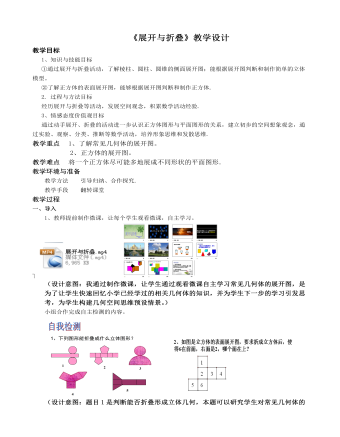
丰富的图形世界 展开与折叠教案教学设计
设计意图:题目1是判断能否折叠形成立体几何,本题可以研究学生对常见几何体的把握是否成熟。题目2是考察正方体的展开图,一方面可以研究学生对几何体的把握,另一方面可以引导学生思考,引出下面要学习的内容。)学生预设回答:题目一:学生应该很容易的说出折叠后形成的立体图形。题目二:①运用动手操作的方法,剪出题目中的图形,折叠后对题目做出判断。 ②利用空间观念,复原展开图,发现6的对面是1,2的对面是4,5的对面是3,进而做出判断。教师引导语预设:① 当学生运用动手操作的方法,可以让学生动手实践一下,下一步再引导学生观察正方体,发现规律。② 当学生运用空间观念,教师要放慢语调,和学生一起想象,锻炼学生空间想象能力。
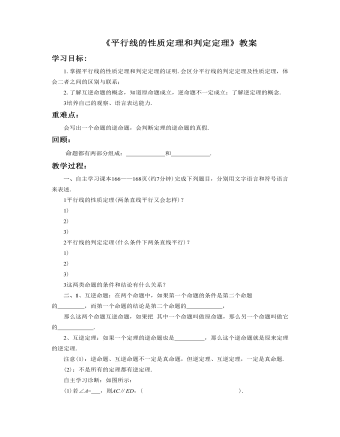
平行线的性质定理和判定定理教案教学设计
1、互逆命题:在两个命题中,如果第一个命题的条件是第二个命题的 ,而第一个命题的结论是第二个命题的 ,那么这两个命题互逆命题,如果把其中一个命题叫做原命题,那么另一个命题叫做它的 .2、互逆定理:如果一个定理的逆命题也是 ,那么这个逆命题就是原来定理的逆定理.注意(1):逆命题、互逆命题不一定是真命题,但逆定理、互逆定理,一定是真命题.(2):不是所有的定理都有逆定理.自主学习诊断:如图所示:(1)若∠A= ,则AC∥ED,( ).(2)若∠EDB= ,则AC∥ED,( ).(3)若∠A+ =1800,则AB∥FD,( ).(4)若∠A+ =1800,则AC∥ED,( ).

初中语文常考常见的别词、别字教案教学设计
1、三年的汗水,终于有了回报。站在领奖台上,她兴奋得不能自己,泪水刷刷地流了下来。误:不能自己 正:不能自已[bù néng zì yǐ] 2、灯光下面,人头攒动。这条街上陈列的,其实大都是膺品,但还是热闹非凡。误:膺品 正:赝品[yàn pǐn]3、待学生从农村基地回来时,校舍已修茸一新,三幢大楼披上了节日的盛装。误:修茸 正:修葺[xiū qì] 4、埋伏在左侧的三连,听到冲锋号响,尤如猛虎下山,直扑敌人阵地。误:尤如猛虎下山 正:犹如猛虎下山[yóu rú] 5、粗制滥造,哄抬市价,这种竭泽而鱼的做法,最后必然会让自己受到惩罚。误:竭泽而鱼 正:竭泽而渔[jié zé ér yú] 6、自从钢琴热掀起后,钢琴教师身价倍增,一批“三脚猫”也混迹其中,滥芋充数。误:滥芋充数 正:滥竽充数[làn yú chōng shù] 7、阳光穿射而入,配着店堂排列得整整齐齐的书架,真是一个书香花香阳光普照的世外桃园。误:世外桃园 正:世外桃源[shì wài táo yuán]8、在调查过程中,陈又将大批赃款转移至岳父处,专案组找他谈话时,他依旧装得若无其事。误:脏款 正:赃款[zāng kuǎn]
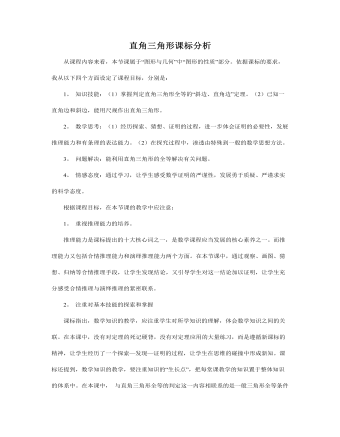
三角形的有关证明 3 直角三角形教案教学设计
从课程内容来看,本节课属于“图形与几何”中“图形的性质”部分。依据课标的要求,我从以下四个方面设定了课程目标,分别是:1。知识技能:(1)掌握判定直角三角形全等的“斜边、直角边”定理。(2)已知一直角边和斜边,能用尺规作出直角三角形。2。数学思考:(1)经历探索、猜想、证明的过程,进一步体会证明的必要性,发展推理能力和有条理的表达能力。(2)在探究过程中,渗透由特殊到一般的数学思想方法。3。问题解决:能利用直角三角形的全等解决有关问题。4。情感态度:通过学习,让学生感受数学证明的严谨性,发展勇于质疑、严谨求实的科学态度。
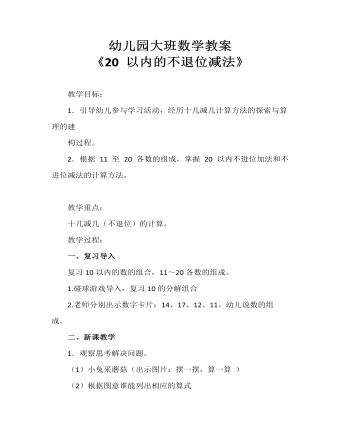
20以内的不退位减法教案教学设计
教学目标:1.引导幼儿参与学习活动,经历十几减几计算方法的探索与算理的建构过程。2.根据 11 至 20 各数的组成,掌握 20 以内不进位加法和不进位减法的计算方法。教学重点:十几减几(不退位)的计算。教学过程:一、复习导入复习10以内的数的组合,11~20各数的组成。1.碰球游戏导入,复习10的分解组合2.老师分别出示数字卡片:14、17、12、11。幼儿说数的组成。
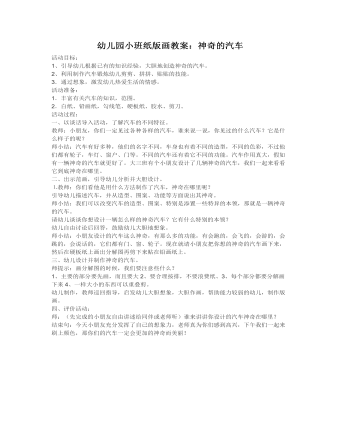
幼儿园小班纸版画教案:神奇的汽车
活动准备: 1.丰富有关汽车的知识,范图。 2.白纸、铅画纸,勾线笔、硬板纸、胶水、剪刀。 活动过程: 一、以谈话导入活动,了解汽车的不同特征。 教师:小朋友,你们一定见过各种各样的汽车,谁来说一说,你见过的什么汽车?它是什么样子的呢? 师小结:汽车有好多种,他们的名字不同,车身也有着不同的造型,不同的色彩,不过他们都有轮子,车灯、窗户、门等。不同的汽车还有着它不同的功能。汽车作用真大,假如有一辆神奇的汽车就更好了。大三班有个小朋友设计了几辆神奇的汽车,我们一起来看看它到底神奇在哪里。
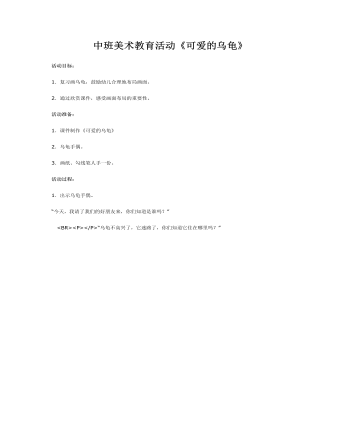
中班美术教育活动《可爱的乌龟》课件教案
2.通过欣赏课件,感受画面布局的重要性。活动准备:1.课件制作《可爱的乌龟》2.乌龟手偶。3.画纸、勾线笔人手一份。
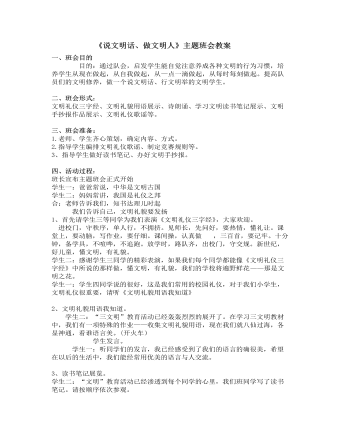
《说文明话, 做文明人》主题班会教案
2、文明礼貌用语我知道。学生二:“三文明”教育活动已经轰轰烈烈的展开了。在学习三文明教材中,我们有一项特殊的作业——收集文明礼貌用语,现在我们就八仙过海,各显神通,看谁语言美。(开火车)学生发言。学生一:听同学们的发言,我已经感受到了我们的语言的确很美,希望在以后的生活中,我们能经常用优美的语言与人交流。3、读书笔记展览。学生二:“文明”教育活动已经渗透到每个同学的心里,我们班同学写了读书笔记。请按顺序依次参观。4、文明手抄报展览。5、为获奖同学颁发奖状。(自制奖状)学生一:我们学了那么多,最终目的就是让我们“说文明话,行文明举,做文明人”。请欣赏〈文明礼仪歌谣〉
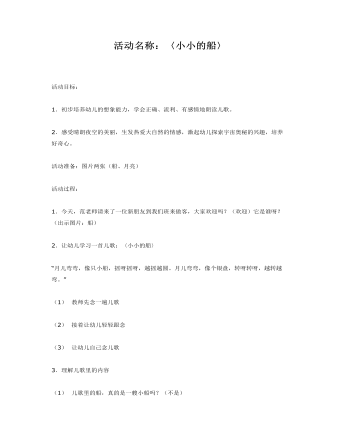
幼儿园中班语言教案:小小的船
2.感受晴朗夜空的美丽,生发热爱大自然的情感,激起幼儿探索宇宙奥秘的兴趣,培养好奇心。活动准备:图片两张(船、月亮)活动过程:1.今天,范老师请来了一位新朋友到我们班来做客,大家欢迎吗?(欢迎)它是谁呀?(出示图片:船)2.让幼儿学习一首儿歌:〈小小的船〉“月儿弯弯,像只小船,摇呀摇呀,越摇越圆。月儿弯弯,像个银盘,转呀转呀,越转越弯。”(1) 教师先念一遍儿歌(2) 接着让幼儿轻轻跟念(3) 让幼儿自己念儿歌
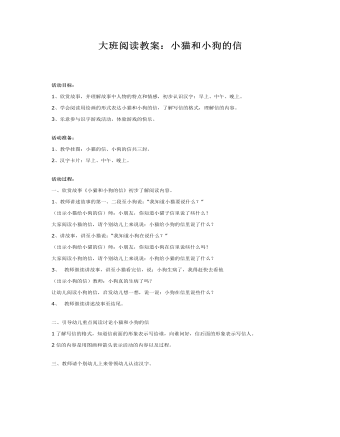
大班阅读教案:小猫和小狗的信
2、学会阅读用绘画的形式表达小猫和小狗的信,了解写信的格式,理解信的内容。 3、乐意参与识字游戏活动,体验游戏的快乐。 活动准备:1、教学挂图:小猫的信、小狗的信共三封。2、汉字卡片:早上、中午、晚上。 活动过程: 一、欣赏故事《小猫和小狗的信》初步了解阅读内容。 1、教师讲述故事的第一、二段至小狗说:“我知道小猫要说什么?” (出示小猫给小狗的信)师:小朋友,你知道小猫子信里说了些什么? 大家阅读小猫的信,请个别幼儿上来说说:小猫给小狗的信里说了什么?
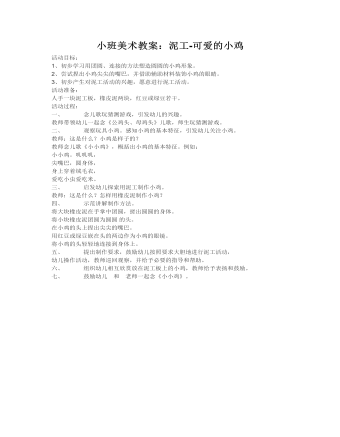
小班美术教案:泥工-可爱的小鸡
2、尝试捏出小鸡尖尖的嘴巴,并借助辅助材料装饰小鸡的眼睛。 3、初步产生对泥工活动的兴趣,愿意进行泥工活动。 活动准备: 人手一块泥工板,橡皮泥两块,红豆或绿豆若干。 活动过程: 一、 念儿歌玩猜测游戏,引发幼儿的兴趣。 教师带领幼儿一起念《公鸡头、母鸡头》儿歌,师生玩猜测游戏。 二、 观察玩具小鸡。感知小鸡的基本特征,引发幼儿关注小鸡。 教师:这是什么?小鸡是样子的? 教师念儿歌《小小鸡》,概括出小鸡的基本特征。例如: 小小鸡。叽叽叽, 尖嘴巴,圆身体, 身上穿着绒毛衣, 爱吃小虫爱吃米。
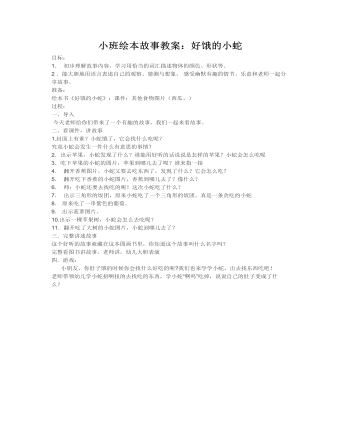
小班绘本故事教案:好饿的小蛇
2 .能大胆地用语言表述自己的观察、猜测与想象, 感受幽默有趣的情节。乐意和老师一起分享故事。 准备: 绘本书《好饿的小蛇》;课件;其他食物图片(西瓜、) 过程: 一、导入 今天老师给你们带来了一个有趣的故事,我们一起来看故事。 二、看课件,讲故事 1.封面上有谁?小蛇饿了,它会找什么吃呢? 究竟小蛇会发生一件什么有意思的事情? 2.出示苹果,小蛇发现了什么?谁能用好听的话说说是怎样的苹果?小蛇会怎么吃呢 3.吃下苹果的小蛇的图片,苹果到哪儿去了呢?谁来指一指 4. 翻开香蕉图片,小蛇又要去吃东西了,发现了什么?它会怎么吃?

小班早期阅读教案《小熊的帽子》
小熊说:“风把我的帽子吹跑了,你愿意帮我去找帽子吗?” 小青蛙说:“行啊,母鸡在孵小鸡,我正想给她送蘑菇去当点心,我们边走边找吧。”走啊走啊,他们遇见了小松鼠。 小熊说:“风把我的帽子吹走了,你愿意陪我去找帽子吗? 小松鼠说:“好啊,母鸡在孵小鸡,我正想给她送伞去呢,我们边走边找吧!”他们走啊走,突然小熊发现了粉红色的帽子。帽子在地上,两只小鸡住在帽子里。 鸡妈妈说:“多亏了这顶帽子,要不然,我的宝宝们会着凉的。 小熊采了一片叶子戴在头上。呵呵,小熊又有新帽子了。 活动目标: 1、 通过观察、理解小熊寻找帽子的有关情节,知道帮助别人是一件快乐的事情。 2、 能正确的翻阅图书,并愿意大胆的讲讲、演演故事中有趣的情节。评价: 第一条目标定位单独看比较的合理,既有故事情节的认知也有情感态度,比较的整合。但是从教师还想融合翻阅的学习和讲述表演的能力,那还需要上下调整。 第二条目标中“能正确的翻阅图书”在过程中涉及的不多,因为以大图书阅读为主,而且“正确”是指什么,不太明确。 调整:1、学习有序翻阅图书,了解小熊寻找帽子的有关情节。2、愿意在集体面前大胆的扮演角色,表演情节感知帮助别人是一件快乐的事情。 活动准备:大图书一本、幼儿人手一本小图书、角色头饰、录音故事比较的充足,也都是能为目标达成服务的。 录音:在孩子还没有能比较熟练的有序翻阅期老师可以调整为教师当场讲述故事,根据孩子的行为来调整翻阅的间隔速度。如果孩子能比较熟练的有序翻阅了,那么可以用录音来统一翻阅速度,这是个别的能力弱的孩子老师可以正对性的帮助了。 活动现场记录:
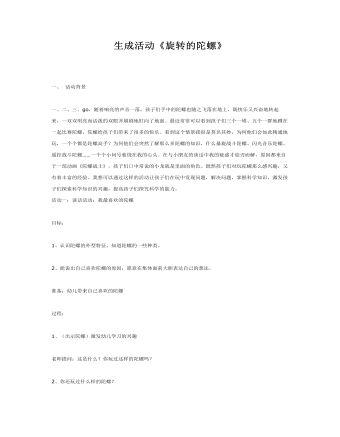
中班主题课件教案:方案活动旋转的陀螺
孩子们口中常说的小龙就是里面的角色。既然孩子们对玩陀螺那么感兴趣,又有着丰富的经验。我想可以通过这样的活动让孩子们在玩中发现问题,解决问题,掌握科学知识,激发孩子们探索科学知识的兴趣,提高孩子们探究科学的能力。活动一:谈话活动:我最喜欢的陀螺目标:1、认识陀螺的外型特征,知道陀螺的一些种类。2、能说出自己喜欢陀螺的原因,愿意在集体面前大胆表达自己的想法。准备:幼儿带来自己喜欢的陀螺过程:1、(出示陀螺)激发幼儿学习的兴趣老师提问:这是什么?你玩过这样的陀螺吗?2、你还玩过什么样的陀螺?徐晟:我玩过拧的陀螺,尤志浩:我玩过木头的陀螺,也叫打不死陀螺;周杰:我玩过装电池有按扭的陀螺,邵未龙:我见过遥控陀螺,很厉害的;周舟:我玩过有发条的陀螺……(评析:这样的谈话可以让孩子了解到陀螺的种类有很多:木头的,塑料的,拧的,有发条的,自动的。)3、你喜欢什么样的陀螺?为什么?郁幸娴:我喜欢音乐发光战斗陀螺,因为它会发出火星;戚奔:我喜欢白虎陀螺,因为它很厉害,可以打败龙陀螺;吕新炜:我喜欢大的陀螺,因为它可以转很长的时间;邵未龙:我喜欢小的陀螺,因为它转的速度很快;邹蓉蓉:我喜欢牵牛陀螺,因为它很好玩;蒋钰:我喜欢铁的陀螺,因为不容易坏……(评析:孩子对陀螺真的是爱不释手,又有过玩的经验,所以在讲的时候能充分表达自己的理由。由于孩子的知识能力有差异,所以喜欢的原因也各不相同。由此可见,我们的谈话内容一定要围绕孩子已有的经验进行。)4、如果让你设计一个陀螺,你想设计一个什么样的陀螺呢? 我想设计一个彩色的陀螺,我想设计一个喷火的陀螺,我想设计一个很厉害的陀螺,我想要一个会飞的陀螺……(评析: 从孩子们的谈话中可以看出他们喜欢陀螺的原因很多,有的是因为动画中的角色厉害他就喜欢那个陀螺,有的是因为转得快,有的是因为转得稳,也有的是因为色彩或图案漂亮。通过与同伴的交流小朋友对陀螺的种类也多了一些了解。那为什么摇摇晃晃旋转的陀螺不会倒下,为什么陀螺旋转的时候会有的快有的慢呢,其中有什么奥秘呢?)
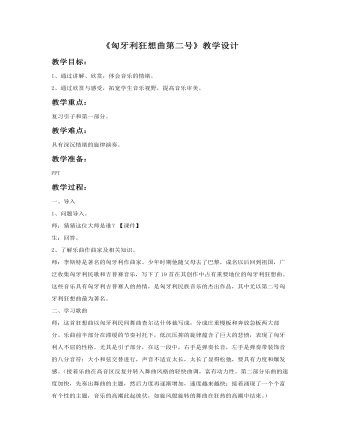
《匈牙利狂想曲第二号》教案
教学过程:一、导入1、问题导入。师:猜猜这位大师是谁?【课件】生:回答。2、了解乐曲作曲家及相关知识。师:李斯特是著名的匈牙利作曲家。少年时期他随父母去了巴黎,成名以后回到祖国,广泛收集匈牙利民歌和吉普赛音乐,写下了19首在其创作中占有重要地位的匈牙利狂想曲。这些音乐具有匈牙利吉普赛人的热情,是匈牙利民族音乐的杰出作品,其中尤以第二号匈牙利狂想曲最为著名。二、学习歌曲师:这首狂想曲以匈牙利民间舞曲查尔达什体裁写成,分成庄重慢板和奔放急板两大部分。乐曲前半部分在滞缓的节奏衬托下,低沉压抑的旋律蕴含了巨大的悲愤,表现了匈牙利人不屈的性格。尤其是引子部分,在这一段中,右手是弹奏长音,左手是弹奏带装饰音的八分音符;大小和弦交替进行,声音不适宜太长,太长了显得松弛,要具有力度和爆发感。(接着乐曲在高音区反复并转入舞曲风格的轻快曲调,富有动力性。第二部分乐曲的速度加快,先奏出舞曲的主题,然后力度再逐渐增加,速度越来越快;接着涌现了一个个富有个性的主题,音乐的高潮此起彼伏,如旋风般旋转的舞曲在狂热的高潮中结束。)

